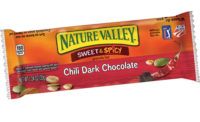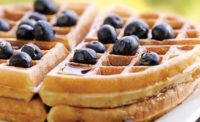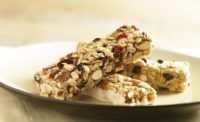Dynamic. Competitive. Innovative. These are just some of the words industry insiders use to describe the snack and nutritional bar market. So it’s no surprise that, according to IRI, Chicago, bar sales are up across the board to the tune of nearly 5 percent in the 52 weeks ending Feb. 21, 2016.
Most of this growth is carried by the nutritional and health value bar segment, which saw a 7.9 percent growth in dollar sales over last year. Leading the way are brands like Clif Bar & Co., which posted a more than 12 percent growth in dollar sales, and KIND, LLC, which posted about 20 percent growth. Dollar sales of granola, breakfast and cereal bars, on the other hand, remained relatively flat.
“The bar market is very strong right now,” says Jim Nagy, president, Carolina Innovative Food Ingredients Inc., Nashville, NC. “Consumers are snacking more, and bars are the best-known snack item for those who are focused on health, and not just indulgence.”
Bar dynamics
In line with the data, Nagy sees stronger growth in the premium, nutritional side of the industry, rather than in traditional, more cost-effective segments like granola. “Bars seem to be doing best among more affluent consumers who are willing to pay for applications with strong health and clean-label claims—non-GMO, alternative sweeteners—and premium ingredients like organic almonds and ancient grains,” he adds.

But as the segment grows, it also shifts, according to Dave Caucutt, vice president of sales and technical services, Lawrence Foods Inc., Elk Grove Village, IL. “The market is becoming more fragmented,” he explains. “There are some national brands, but many more regional and local players. Barrier to entry is low, so many marketers are avoiding brick-and-mortar investment, focusing on formulation and positioning instead. Specialty bars have been launched to cater to many needs―cycling, muscle recovery and stress reduction, to name a few.”
Jeannie Swedberg, director of business development, Tree Top Inc., Selah, WA, notes: “The bar market is quite dynamic and, as a result, somewhat crowded. Large players and small ones market novel ingredients to every imaginable consumer group and then some—even insectivores with cricket flour bars.”
For Greg Paul, Ph.D., marketing director of nutrition bars and beverages, North America, DuPont Nutrition & Health, St. Louis, brands need to be creative and innovative to stand out as their competition and merchandising opportunities expand. Look no further than retailers stocking nutritional bars where candy bars used to be in the checkout lanes for evidence of this, he points out.
“The biggest challenge in the bar category is staying relevant to the consumer,” says Paul. “With so many offerings available, creating brand differentiation to attract and retain consumers is incredibly challenging. The successful companies effectively segment the market and target offerings providing compelling benefits that also meet with consumers’ taste and value thresholds.”
Fruits, nuts and seeds
It’s no secret that clean-label remains a trend, especially in a category appealing to nutritionally minded shoppers. And when it comes to bars, the solution hitting home with many consumers is the inclusion of fruits, nuts and seeds, because they’re nutritionally rich and recognizable on the label.
“The snack bar market mirrors the general food space in that consumers want clean-label ingredients that are familiar to them, like fruits, nuts, seeds and grains,” says Swedberg, noting a rise in the use of fruit purées and concentrates as sweeteners as manufacturers tap into the naturally perceived sweetness of fructose, as well as the antioxidant, micronutrient and fiber benefits of fruits. “Notice the use of clear packaging, so consumers can see the ingredients in the bar,” she adds. “There’s nothing to hide, because all the goodness is visible.”
Tree Top offers a broad range of fruit ingredients for use in snack bars, from fruit pieces and powders to fruit fiber, fruit purées and juice concentrates. Swedberg anticipates that the use of fruit in bar applications will only continue to rise as the FDA proposes including “added sugars” on the Nutrition Facts panel soon. “Dried fruits and fruit purées provide a sweet note and may assist in reducing the amount of added sugar needed in bar formulations,” she says.
“Bars require significant amounts of sweeteners to bind together ingredients, so healthier sweeteners are going to be a focus for the future,” says Nagy. “That includes sweeteners like honey and maple syrup, as well as sweet potato juice concentrate, which performs really well as an alternative sweetener, while also offering the health halo that consumers associate with sweet potatoes.”
As nuts and seeds turn up in nutritional bars, Paul warns of the one-year shelf life of such ingredients, which easily oxidize and can produce rancid off-flavors. “Historically, artificial preservatives were used in bars with nuts and seeds to prevent oxidation,” he adds. “With today’s clean-label trends, natural preservatives are preferred, especially in categories like nutrition bars.” DuPont offers a line of natural antioxidants that supports the use of nuts and seeds in such applications.

According to Molly Spence, director, North America, Almond Board of California, Modesto, consumers surveyed in the 2014 “U.S. Bars Exploratory Study” by the Sterling-Rice Group ranked almonds as the most-desired ingredient in their ideal snack bar, because they feel almonds make bars crunchier, more nutritious and tastier. “Almonds can help manufacturers incorporate sought-after textures and nutritional benefits, while keeping a clean label in new product formulations,” she says. “They also are the number one nut that consumers associate with being heart-healthy and helping with weight management, making them a great addition to bar formulations now and in future developments.”
Protein maintains its position
Though its roots are with bodybuilders and athletes, protein is now one of the top ingredients consumers of all types look for in bars. “Plant proteins like soy and pea have strong appeal for general health and wellness,” says Paul. To that end, DuPont offers a line of soy-protein isolates and nuggets specifically created for nutrition bars.
In addition to its protein content, the line packs a satisfying crunch and helps control texture to enable bars to deliver on the shelf-life requirements needed to succeed in the market, explains Paul. “Firm, soft, crunchy or chewy, soy protein works with all textures to deliver and maintain eating quality throughout the life of the bar, while delivering a high-quality protein source consumers demand,” he adds. “Because of the wholesome, natural image associated with nutrition bars, plant proteins are a perfect fit. Whole grains, fiber and nuts are also desirable, but that first nutrient consumers look for on the nutrition facts panel of a nutrition bar is protein.”
But protein also presents a significant challenge for bar manufacturers, says Brian Armstrong, senior director of innovation and research and development, Bunge North America, St. Louis. That challenge is a less-than-desirable taste. “If a bar is made from a single source of protein, those notes may be difficult to mask and can interfere with the taste,” he explains. By diversifying the bar’s protein sources—using soy, pea and grain proteins together—negative taste can be more easily diluted, he adds.
“We see this as a major opportunity for growth,” Armstrong says. “If the bar has a blend, you’ll create a product that delivers the protein customers seek, and that tastes good, too.”
Future focus
“Bars aren’t just snacks anymore; they are meal replacements,” says Jamie Wilson, director of marketing and culinary innovation, Parker Products Inc., Fort Worth, TX. “The opportunity for growth is knocking down the door in 2016.”
According to Wilson, future trends might include bar dippers, which may feature a bar, sauce and particulate to enhance flavor and offer different textures. “The sky’s the limit,” she says. Inclusions in variations like birthday cake, doughnut, lava cake and sea salt caramel are designed to complement finished bars, appealing to any taste.

Eric Aasen, vertical product manager, Bosch Packaging Technology Inc., New Richmond, WI, predicts a more-individualized approach to bars as the niche markets continue to gain momentum. He notes such approaches can take the shape of new flavors (meat bars and other new recipes), packaging (opening aids, resealables, etc.), age-related demands (from an aging population with decreased senses and lower dexterity) and nutrition (nutraceutical ingredients and food supplements). The challenge, he predicts, is that niche customization will demand more flexibility, more formats, smaller production quantities and shorter conversions of production plants. Bosch is prepared to help its customers at all steps of production, from processing raw ingredients to testing and producing new products to packaging new products for sale.
Corbion Caravan, Lenexa, KS, is also prepared to help brands take a more-flexible and customized route going forward with its fortification blends, which are customizable based on nutritional expectations. Additionally, Cara Crunch, the company’s instant dry mix, works in a wide variety of bars. “Customers can incorporate as many or as little inclusions as they want, and then just mix and bake,” says Abby Ceule, director of market management, breads, Corbion Caravan. “From one simple mix, you can create a multitude of brittles, breakfast or gourmet bars. Items made with Cara Crunch look upscale, but are easy and cost-efficient to make. There’s no waste, stales or shrink.”
Caucutt sees customized products on the horizon geared toward child and senior nutrition, specifically, in addition to products that are highly indulgent, have savory flavors and are nutrient-specific.
“We’ll probably see further segmentation for particular nutritional needs and more flavor combinations, from sweet to savory and all stops in between,” says Swedberg. “But in the long-term, wholesome bars with familiar ingredients and flavor profiles will be the top-sellers.”




